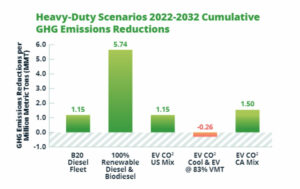New diesels can cut emissions faster than electric trucks, study says
Converting to modern diesel engines is a quicker and less costly way to lower harmful emissions than adopting of electric vehicles, especially if now-available near-zero-emissions diesels run on renewable biofuels, says a study commissioned by a diesel advocacy group.
Adoption of electric vehicles, few of which are currently available, would cost a trucking fleet three times more than converting to today’s new-technology diesels, the study by Stillwater Associates adds. The study for the Diesel Technology Forum looked at air-quality conditions in 10 Northeastern states that have adopted California’s regulations for low-emission and zero-emission vehicles, then drew its conclusions.
New tech diesel engines
New technology diesels are those built since 2007, when diesel particulate filters were adopted, explained Diesel Technology Forum’s executive director, Allen Schaeffer. Diesels from 2010 and newer added nitrogen oxide-reducing equipment to make the engines cleaner. A forum survey showed that 53% of trucks now in service have new-tech diesels, but considerable benefits would come from retiring the other, older trucks and replacing them with the cleaner vehicles.
Cutting particulate matter, commonly called soot, has the greatest benefit to improving air quality, especially in large cities in the Northeast, said Gary Yowell, the Stillwater researcher who did the study. Experts claim that soot harms lungs and leads to numerous health problems. Diesel particulate filters used since 2007 cut soot by about 98%.

By comparison, electric medium- and heavy-duty trucks would cut soot by 95% when power-plant emissions are factored in, Yowell said. Although solar and wind generation is increasing, many electric-generation plants still use coal, which cannot burn as cleanly as modern diesels.
Meanwhile, air-quality analysis in northeastern cities shows that cutting nitrogen oxide is not as beneficial as particulate matter reduction, as levels of harmful ozone in those cities have remained the same, he added. The states in the studied area are Connecticut, Delaware, Massachusetts, Maryland, Maine, New Jersey, New York, Pennsylvania, Rhode Island and Vermont.
“The urgency to implement solutions to reduce greenhouse gases from transportation and address climate change is heard on a daily basis,” Schaeffer said. “Transitions to new energy sources still have considerable uncertainties and longer timeframes – a decade or more – to meaningful implementation… Advanced diesel technology, as well as renewable and biodiesel fuels, are key available solutions that can deliver big impacts today.”
Comparing fuels
Low-carbon, renewable bio-based diesel fuels cut emissions even more, he said. These fuels can be used in all diesel vehicles today, so fueling those in the study area with 100% renewable diesel resulted in three times larger cumulative greenhouse-gas reductions by 2032 than the EV scenarios, analysis indicates. The results were about the same if B20 – a 20% blend of biodiesel with 80% petroleum diesel – were used.
Electric trucks beat diesels in reducing nitrogen oxide emissions, the study notes. However, electric trucks are generally deployed on shorter routes and run shorter distances than comparable diesel vehicles, so NOx emission reductions with advanced-technology diesels would be greater on a cumulative basis.
The cost of electricity that would run electric trucks is lower now than for diesel, but that’s partly because there’s no road tax on electricity, Yarnell said. If and when authorities add road taxes, the business case for electric trucks would suffer. LL
More business news is available on LandLine.Media.









